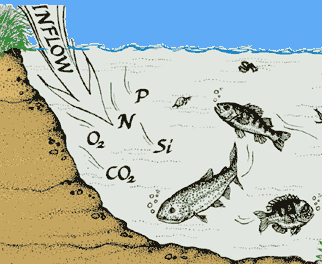AQUATOX
Linking water quality and aquatic life

AQUATOX models the fate of various pollutants and how they affect aquatic life.
AQUATOX is a simulation model for aquatic systems. AQUATOX predicts the fate of various pollutants, such as nutrients and organic chemicals, and their effects on the ecosystem, including fish, invertebrates, and aquatic plants. This model is a valuable tool for ecologists, biologists, water quality modelers, and anyone involved in performing ecological risk assessments for aquatic ecosystems. Although incorporating constructs from classic ecosystem and chemodynamic models, AQUATOX was developed from the beginning as an applied model for use by environmental analysts.
AQUATOX 3.2 includes the following interface enhancements:
- Update to AQUATOX Database Management System: The paradox database management system (used in previous versions) has been replaced with SQLite databases.
- Capability to save all inputs and outputs to a text file: AQUATOX now can write all model inputs and outputs in ASCII format by saving files with a “*.txt” extension. This allows users to view and change model inputs without using the graphical user interface.
- Command Line Version: Users may now execute and manipulate the model using a DOS command prompt.
- For information about how to use each of these interface updates, please see the Release 3.2 User’s Manual.
Nearshore Marine Environment
AQUATOX Release 3.2 was designed to extend the existing AQUATOX estuarine version to include improved capabilities for situations encountered in the nearshore marine environment. Several changes were required to model food webs in the marine environment. The most notable updates include:
- Additional equations to model the physical complexity of oyster reefs and the marsh-edge environment.
- The capability to model size-classes of oysters and crabs within the model.
- New invertebrate-modeling capabilities including allometric bioenergetics equations and burrowing refuge from predation.
- To better represent marine-biology conventions, the guilds used by AQUATOX to characterize these state variables were reorganized.
- Four new nearshore-marine studies are included in this version representing “marsh edge,” “exposed beach,” “soft bottom,” and “oyster reef” habitats. Numerous nearshore-marine animal- and plant-parameter records have been added to the AQUATOX databases.
AQUATOX Release 2 underwent an external peer review in late 2003. Release 3 underwent external peer review in late 2008.
- What's new in Release 3.2?
- Basic Information
- What does AQUATOX do?
- Training - classes and downloadable presentation materials
- Frequently Asked Questions
- AQUATOX Email Listserv
- Peer Review
- Publications About or Referencing AQUATOX
- AQUATOX Supporting Documentation
- Modeling Periphyton with AQUATOX
- Download the model
- Data sources
| Version | Release Date |
|---|---|
| Release 3.2 | September 2018 |
| Release 3.1 Plus | May 2014 |
| Release 3.1 | late 2013 |
| Release 2 | late 2003 |
| Release Notes | |
Contact
For questions about AQUATOX you may contact Brenda Rashleigh (rashleigh.brenda@epa.gov), Atlantic Ecology Division, Office of Research and Development, 27 Tarzwell Drive, Narragansett, RI 02882 (phone: 401-782-3014).
